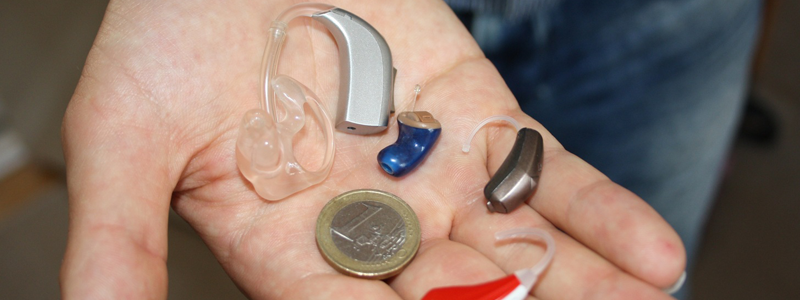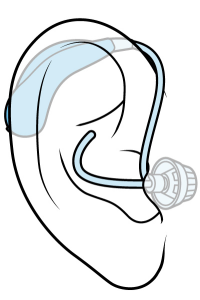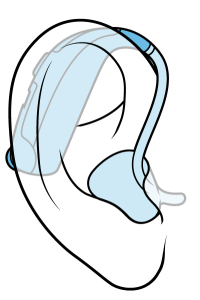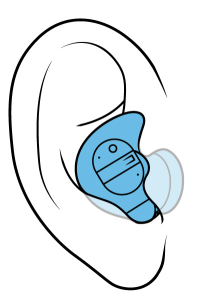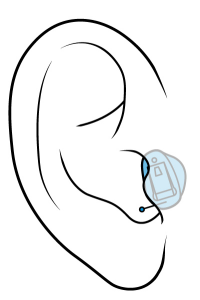Hearing loss can affect anyone at any stage of life, this is the most common. If you think, you or a loved one is suffering from hearing loss, and you are looking for the best hearing aids or hearing amplifiers, then you are in the right place.
If someone professionally diagnosed with hearing loss, typically the degree of hearing loss can be divided into four categories.
- Mild hearing loss
- Moderate hearing loss
- Severe hearing loss
- Profound hearing loss
Choosing the best hearing aids is a somewhat different task from selecting wireless earbuds because these devices are designed for better listening and conversation. They reduce the background noise and also come with frequency shifting, feedback suppression and many different types of technology which make conversation better in any environment.
These hearing amplifiers can help you to listen more accurately, make conversation better, so you will get your life back.
There are several types of hearing amplifiers available on the market, first, you have to know which level of hearing loss you have? then we will choose best hearing aids according to hearing loss. However, if you still don’t know about your hearing loss level, no problem! we will provide some basic information to help you to better understand.
You can go directly to our Buyer’s guide section, where we have explained
- What is your hearing loss level?
- What to look before purchase a hearing amplifier?
- Which type of hearing aids suitable for me?
- And all those questions, that probably coming in your mind.
After clearing your doubts, you can choose your best hearing aids later.
Best Hearing Aids or Hearing Amplifiers
In past, hearing aids faced many challenges, and now they are becoming a lot better.
There are many implementations being done in these hearing amplifiers by their manufacturers like digital noise reduction, feedback suppression, frequency adjustments, and many more.
I hope this post will help you to find your best hearing aids or hearing amplifiers.
Take a look below at our comparison table, where we have compared some important features of different hearing amplifiers and if you want to read the full review of product click on products name.
Best Hearing Aids or Hearing Amplifiers – Reviews
1. Empower Hearing Amplifier – Editor’s Choise
The Empower hearing amplifier is a Mini-Behind-the-Ear (mBTE) hearing device.
Unlike many other hearing aids that amplify every noise around along with speech, this Hearing aid amplifies the selective sound speech, so the unwanted background noise doesn’t come in the hearing.
This best hearing aids comes in very small size (almost thickness of a pencil), which sits comfortably behind your ear, and a very thin and barely visible sound tube delivers the voice into ears. Overall, this whole unit is very comfortable and doesn’t give you plugged-up feeling.
However, because of its too small size, it can be misplaced easily, so you have to be carefully kept at all times.
According to the manufacturer, the Empower hearing amplifier features 12- band digital processor, which help the user to better understand the conversation along with filter out unwanted noise. Apart from that, it is also very energy efficient.
When we talk about battery backup, which is quite good as well, and they are providing 8 batteries additionally.
That’s being said, the Empower hearing aid having versatile hearing settings, which allow users to adjust the volume and frequency to suit their hearing needs. For ease of usability and access, this device accompanies volume/intensity programs, which can be trigger through provided adjustments button which is placed on the side behind-the-ear tube.
The Empower hearing amplifier is the best hearing aids, which features good noise cancelation, long battery life, amazing voice clarity and very comfortable and invisible design.
This device is highly recommended for up to the severe hearing loss and below, due to its versatility of frequency and volume level. Price is slightly higher, but when we consider the features, quality, and performance, then that is acceptable.
-
PROS
- Barely visible
- Light-weight
- Feedback suppression
- 4 Programs
- 12 Channels
- Noise cancellation
- 40 Decibels gain
- Very thin size
- 8 Battery extra included
- 12 Months warranty
-
CONS
- Can be lost easily, due to small size
2. Williams Sound Pocketalker Ultra (Top Amplification)
The Williams Sound Pocketalker Ultra is a hand-held hearing amplifier. This pocket hearing aid is ideal for mild to moderate hearing loss person. The size of this hearing aid is small, so you take it anywhere. It is very useful for one to one conversation, tv listening, small groups etc.
The Williams (PKT D1 EH) boost the sound according to your volume you’ve set on the device.
The sound quality of this hearing amplifier is amazing, additionally, it filters out a considerable amount of the background noise.
Amplification gain of this device is 20-40 decibels, this range is ideal for mild to moderate hearing loss affected person. Moreover, the battery life of this pocket hearing aid lasts up to 100 hours. This unit runs on 2x AAA batteries, but you have to keep in mind that turn off the device when not in use, however, it has a small red-light indicator, that will notify you if you accidentally leave it running.
The Williams hearing amplifier has a variety of earphones and headphone that you can use with it. Honestly, the earbuds, which provided with this device are not very good, so you can replace them with somewhat high quality that will help with getting clear sound along with comfort.
This pocket amplifier comes with 12 ft. extension cord, which is great for watching TV. You have to just put the microphone close to the TV and you will able to hear clear sound in low volume without disturb other.
This device is good for those who regularly misplaces hearing aids and they don’t wear them.
The Williams Pocketalker is a perfect amplifier for mild to moderate hearing loss, which features decent sound amplification with noise cancellation.
If you are not ready for professional hearing aid, then you should have to try this budget pocket amplifier.
-
PROS
- Best amplification
- Custom earphone compatible
- Ideal for TV listening
- One-on-one or small group conversation
- 100 Hours battery backup
- 20 AAA Battery extra included
- 5 Year warranty
-
CONS
- Heavy size
- Problematic in noisy environment
3. Otofonix Elite Personal Sound Amplifier (Ideal for Severe hearing loss)
The Otofonix Elite Personal is a Mini-Behind-the-Ear type of Hearing Aid. which fits perfectly inside the ear, and barely visible.
This hearing aid equipped with 12 bands digital sound processing, which limits the output to prevent excessively loud sounds. Moreover, you are getting 10 volume levels and 4 memory frequency settings, and those all settings can be adjusted with one finger.
These 4 presets can be used for following environments.
- Normal setting – This mode is for regular listening, and this remains selected by default.
- Noisy setting – As per its name this mode is very useful in the noisy environment, this reduces the background noise and make listening and conversation more accurate.
- Treble setting – When this mode is enabled, then hearing amplifier will decrease the high-pitched sounds like. Whistling, feedback, squealing etc.
- Quiet setting – In the quiet environment, this mode should be enabled for battery saving.
The Otofonix hearing aid is having excellent background noise reduction and acoustic feedback cancellation. Additionally, they are proving multi sizes of dome ear tips, so they will fit perfectly in the ear and reduce feedback.
Please keep in mind that this device is not for the people with above moderate hearing loss.
We don’t have any obnoxious thing about this device, this hearing amplifier is accompanied 100% digital circuitry, 4 channels, 12 bands digital sound processing, volume adjustment and good battery life.
Otofonix elite is the best hearing aids for Mild and Moderate hearing loss person. Honestly, the price of this hearing aid is somewhat higher, but if you have the serious hearing loss then this deal is recommended after Empower.
-
PROS
- Feedback suppression
- 12 Channels
- 4 Programs
- 10 Volume levels
- Noise cancellation
- 40 Decibels gain
- Speech Frequencies sound amplification
- Ideal for serious hearing loss
- 6 Battery extra included
- Light-weight
- 30-Day Free Returns
-
CONS
- Somewhat Expensive
4. Britzgo BHA-220S (Cheap and Good Hearing Aid)
The Britzgo Hearing Amplifier BHA-220S is a digital hearing amplification device. This hearing amplifier is good for severe hearing loss due to better decibel gain.
This device is having a super-efficient power consumption, so its battery last up to more than 500 hours. This makes it far better than most rechargeable hearing aids, which usually require charging once in every few days.
Aesthetically, unlike other hearing aids, the Britzgo hearing amplifier comes in modern stylish design, which is quite fashionable.
Apart from that, this hearing amplifier has a great range of frequency settings and works straight out of the box.
The best thing about this device is, this offers flexible amplification, making it good for those with the severe hearing loss. Additionally, there are 4 program modes, they make converse and listening more convenient according to the environment.
It’s new generation digital chip offers, noise reduction feature, which is quite useful to converse in the noisy environment. Stable voice amplification provides smooth sound quality, and one finger control makes it more convenient.
If you are looking for cheap FDA approved hearing amplifier, The Britzgo BHA-220S hearing amplifier is the good choice for severe hearing loss people, which offers longest battery life, noise reduction and 4 program modes in a stylish modern body.
-
PROS
- FDA approved
- 500 Hours battery life
- Noise cancellation
- 2 Battery extra included
- Cheap option
- Fancy design
- 90 days return policy
- 1 Year warranty
-
CONS
- Plugged-up feeling
- Single channel
5. Banglijian Ziv-201 (Rechargeable Hearing Aid)
Most of the hearing device comes with the disposable battery, some of them work for months, and some discharge within the week. This backup time is totally depended on device circuitry.
Unlike other devices, The Banglijian Ziv-201 Hearing Amplifier comes with rechargeable battery, so you don’t have to worry about changing them.
The Ziv-201 is good for having watching TV or having conversations, most users state that this device simplifies well sound without distortion. Additionally, this device comes with noise reduction technology, so it is very helpful in the noisy environment, where background noise is occurring, like restaurant, road, mall.
This hearing amplifier offers only two levels of settings: Normal and noisy mode with 5 level of volume adjustment in each level.
The best thing about this device is, this runs on a built-in lithium rechargeable battery, which can be charged with the USB cable and power adaptor, that comes with this hearing aid. So, you don’t have to buy the extra battery for this device. Apart from that, this battery can be fully charged in 2 hours and provides backup to about 24 hours.
If you are looking for moderate price rechargeable amplifier, which makes your listening easier, especially conversation and TV, the Banglijian Ziv-201 is a recommended model to check out.
Besides that, they have a 60 days return policy, so you can try it out, and return if you find any obnoxious thing about this device.
-
PROS
- FDA approved
- Rechargeable
- Noise cancellation
- 5 Volume level
- 90 days return policy
- 3 Years warranty
-
CONS
- Somewhat Expensive
- 2 Programs
- Single channel
6. Neosonic (Another Good Choice for Severe Hearing Loss)
The Neosonic is also a mBTE hearing amplifiers, which is of a very small size, so that is very comfortable to wear. This device works well with the mild to severe hearing loss person.
That’s being said, the Neosonic is having 57 decibels of peak gain, and 4 channels processing which makes conversation easier. They have provided four programs settings which work according to the environment and can be adjusted by the user.
Moreover, this hearing amplifier can be wear in both ears and provides pure digital sound. The Neosonic hearing aid is durable and easy to use, and when we talk about battery backup, that is also good.
According to the manufacturer, this device offers 4 listening programs, which are following.
- Normal – This setting will equally amplify all frequency and remains selected by default.
- Noisy – This mode is very helpful where background noise is available, it’s noise cancellation technology reduce the considerable amount of noise (like wind, road, and restaurant)
- Outdoor – This preset setting limits the sound gain and provides smooth listening.
- Meeting – In this preset mode the hearing aid only increase the voice frequency and decrease the base along with high-frequency sounds.
This hearing amplifier is having less than 1% distortion and reduce the noise with 8 channel suppression technology.
45 days free return and 1-year manufacturer warranty make this deal more attractive, at the reasonable price. You can check this out the deal and return it if this is not suitable for you.
The bottom line is that the Neosonic hearing amplifier is a good BTE device, which delivers commendable noise suppression, 4 listening program, long battery life, and durable quality, that is suitable for mild to severe hearing loss person.
-
PROS
- Noise cancellation
- Convenient to use
- 4 Programs
- Durable
- Small
- 4 Channels
- 7 Battery extra included
- 45 days return policy
- 1 Year warranty
-
CONS
- No feedback suppression
Best Hearing Amplifiers – Buyer’s Guide
Which level of hearing loss do I have and what is the best hearing aids for me?
A person’s hearing loss is typically categorized into four parts, i.e. “mild”, “moderate”, “severe” and “profound”. These terms are used by hearing professional and audiologists.
Below is a brief explanation of the level of hearing loss, in general, the more severe the hearing loss, the harder it is for the person to listen.
Mild
Mild: – This type of hearing loss level is the most common and under-diagnosed.
The people affected with mild hearing loss usually can hear sound louder than 40 decibels, but they may have some difficulty to hearing sound that is below 40 decibels.
Here is some example in real life,
- The sound of soft speech is about 50 decibels.
- The sound of the refrigerator is about 40 decibels.
- The whispering sound is calculated is about 30 decibels
- Falling leaves sound is about 20 decibels
- And normal breathing sound is about 10 decibels
So, someone with the mild hearing loss, may not feel problem in communication in a quiet environment, talk with one person or a couple of people. But they tend to have difficulty hearing the softer environmental sound as well as some conversation, especially in larger-group conversation or over the phone.
Moreover, people with affected with mild hearing loss also may need to more concentrate to follow the conversation when a child of women is talking.
For this level of hearing loss, you don’t have to spend thousands of dollars on hearing amplifiers, there are lots of cheap option available.
Minimum hearing sensitivity – 40 decibel
Moderate
Moderate: – People with moderate hearing loss have the problem hearing sound below 40 decibels, as well as 41 to 60 decibels range.
The sound 41 to 60 decibels range include those heard in a quiet office, for example. Normal conversational speech sound is about 50 to 65 decibels.
The bottom line is that the person affected with moderate hearing loss may have the problem in conversation without hearing aids of any listening device.
For moderate hearing loss persons, it is recommended to use hearing aids or hearing amplifiers.
Minimum hearing sensitivity – 60 decibels
Severe
Severe: – People with severe hearing loss have the problem hearing most sounds below 61 decibels as well as 61 to 80 decibels. The sound in the 61 to 80 decibels include a hair dryer or vacuum cleaner and a garbage disposal.
The person affected with severe hearing loss is highly recommended to use hearing aids or hearing amplifiers. Because they likely would have difficulty even loud speech without amplification.
Unfortunately, hearing aids for this level of hearing loss are somewhat expensive then others.
Minimum hearing sensitivity – 80 decibels
Profound
Profound: – A person with profound hearing loss can only hear a very loud sound that is above 81 decibels. A food blender or mixer sound is about 85 to 90 decibels.
Apart from that, profound hearing loss affected person would not hear any speech, only very loud sound. They most often have difficulty hearing and following conversation even with hearing aids or hearing amplifiers.
We strongly recommended people struggling with hearing loss to visiting a hearing healthcare professional. Unfortunately for this level hearing loss, the hearing aids are too expensive, and can’t help you too much.
What to look before choosing the best hearing aids or hearing amplifiers?
1. Types
Hearing aids come in many styles, but mostly five of them are important and popular. according to a survey, the majority of hearing aids types is mini-behind-the-ear, that most people used.
1. Mini-Behind-the-Ear Hearing Aid (mBTE): – This type of hearing amplifiers is the most popular, and they also are known by the following names.
- Canal receiver technology (CRT)

Image Source - Receiver-in-the-canal (RIC)
- Receiver-in-the-ear (RIE)
- Receiver-in-the-aid (RITA)
In mBTE hearing aids, the sound is delivered to the ear through a custom-made earmold or non-custom dome-style ear-canal, and a thin wire. The earmold is a piece of soft material that fits snugly in the ear.
Pros: –
- Prevents a plugged-up feeling
- Almost invisible
- Comfortable
Cons: –
- On low frequencies, does not allow significantly amplification.
- Wax and moisture buildup may reduce the life of the receiver
2. Traditional Behind-the-Ear Hearing Aid (BTE): – In this type of hearing aids all circuitry is placed behind the ear, in a plastic case, and the sound is delivered through a tube and custom earmold, which is worn in the ear.
Pros: –
- Considerable low and high-frequency amplification.

Image Source - Ideal for severe hearing loss.
- The larger battery provides more power
- Telecoil mode available
- Easily cleanable earmold
- Because of snug fit feedback is rare
Cons: –
- Custom molds are visible
- Wax and sweat buildup (but easily cleanable)
- Earmold can cause a plugged-up feeling due to snugly and entire ear fit.
3. Traditional In-the-Ear Hearing Aid (ITE): – All circuitry is included in the case, which rests in the bowl of the outer ear.
Pro: –
- Easy to insert

Image Source - Less plugged-up feeling
- Directional microphone
- Wireless streaming
- Telecoil feature available
Cons: –
- Somewhat more visible
- the telecoil is may not powerful as BTE
4. In-the-Canal Hearing Aid (IIC): – These hearing aids units are somewhat smaller than traditional ITE, so they sit deep in the canal.
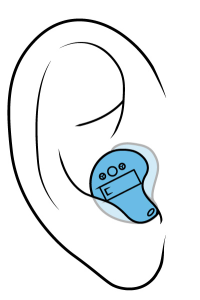
Pros: –
- Less of plugged-up feeling
- The larger unit may include directional microphones.
Cons: –
- Less battery life
- Some users may feel problem to hand and adjust
- Earwax and moisture can create the problem for them
5. Completely-in-the-Canal Hearing Aid (CIC): – The CIC hearing amplifiers relatively too small, and fit deep inside the ears.
Pros: –
- Less feedback

Image Source - Low visibility
- Less sensitive to wind noise
Cons: –
- Directional microphone not available due to the small size
- Might feel plugged-up feeling when the hearing aid is vented
- Wax and moisture buildup vulnerable
- Battery life is short and difficult to remove
- These hearing amplifiers also may be difficult to handle and adjust
2. Directional Microphone
Most of the modern hearing aids have a directional microphone. This feature is very helpful to converse in a noisy environment when you are close to your sound source. While the directional microphone is working, it will not pick sound from your side or rear.
Almost all hearing aids with this feature are able to switch between directional and omnidirectional setting depending on the environment. But it can also pick-up the wind noise, so that is the negative side.
So, this is a considerable feature, which should be available in the best hearing aids.
3. Telecoil
The telecoil is a small sensor, which places in the hearing amplifiers. When activated, it can pick up a magnetic signal from the hearing-aids-compatible telephone, public address systems and those that may be available in concert halls, museums, taxis, or conference rooms, and convert that into sound.
Such technologies are very helpful for those with moderate to profound hearing loss.
4. Feedback Suppression
Proper fitting of hearing aids can reduce feedback. The feedback, suppression or digital feedback reduction, helps quell high-pitched whistling sounds. Most modern best hearing aids include this feature, it’s useful for minimizing feedback if you’re close to the telephone or the aid is slightly dislodged from your ear when you move your jaw.
The listeners who have good hearing in the lowest pitches, this feature allow for more comfort and sound quality.
5. Digital Noise Reduction (DNR)
This feature can improve communication in noisy environments by blocking background noise and makes it easier to hear an understand speech.
However, this is the most common feature which can found easily but this also a considerable factor before going to purchase the best hearing aids.
6. Other features
Apart from that, there are tons of features available in hearing aids or hearing amplifiers, which doesn’t too important at all.
Most newer aids accompany manual and automatic volume control, wireless connectivity between hearing aids, low-battery indicator. Another newer feature is Bluetooth wireless technology, which allows users to stream music and call from the computer, smartphone, and TVs directly through their hearing aids.
I personally recommend, don’t go with any unwanted features which cost you more.
The best hearing aids should come with clear voice quality, noise reduction, perfect fitting and easy to use. Don’t go with WiFi or Bluetooth enabled hearing aids, they will only cost you more and doesn’t have too useful. And if you have not the budget problem, I still not recommends them.
Conclusion
Finally, as you can see in our rundown, we listed only mBTE and BTE type of best hearing aids, accept Williams pocketalker. Because these types of devices are more convenient, cheap and easy to use.
Moreover, we also not listed any expensive devices, like this.
However, these types of device offer tons of features, but some features of them worth nothing, so we did not recommend them. Because our aim is to provide the best devices at a reasonable price.
Overall, the Empower is the best hearing aids, because this device is capable up to the severe hearing loss. Due to its versatile frequency and volume level.
However, if you want the good hearing device in the budget then Britgzo can be considered.
If your budget slightly higher, then Otofonix is the best is the solid choice after Empower. On the other hand, if you are ok with traditional amplifiers, then Williams is the perfect hearing amplifiers in the low price range with top sound quality.
Banglijian Ziv-201 is the only device on our list which comes with rechargeable battery, if you prefer rechargeable device then you can try this out, however it is not recommended for severe hearing loss. While in this price range Neosonic is another option to consider, which offers some good quality than the Banglijian Ziv-201 except the rechargeable battery.
If you think, we have missed out some best hearing aids or If you have any suggestion or feedback, please comment us below without hesitation.
